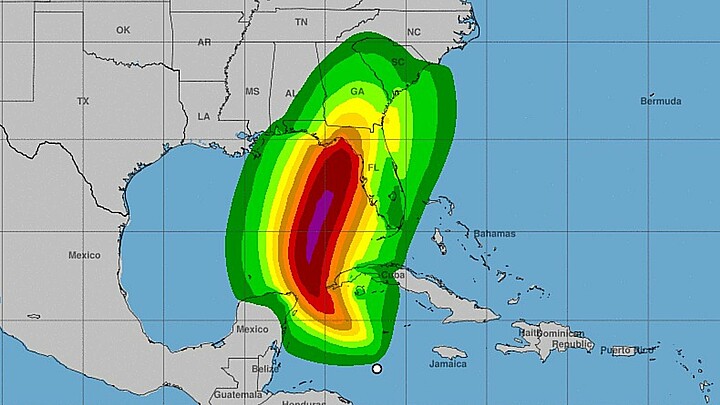Climate
Alert: New storm system brewing in Caribbean could become hurricane heading toward Cuba, Florida
Meteorologists give an 80% chance that the low pressure system will become a hurricane in the coming days

November 12, 2024 5:17pm
Updated: November 13, 2024 9:10am
A new storm system drifting in the central Caribbean is producing an area of intense thunderstorms that could evolve into a hurricane heading toward Cuba and southwest Florida, according to reports Environmental conditions appear conducive to its development, making it likely that a tropical depression will form at the end of the week as the system slowly moves westward in the western Caribbean, the National Hurricane Center reported Tuesday.
According to meteorologists, the disturbance, currently known as 99L, is expected to drift over the western Caribbean Sea until the weekend and begin to move slowly towards the northwest at the beginning of next week with the possibility of affecting southern Mexico and Cuba, which was recently struck by both Hurricane Rafael and Hurricane Oscar.
It could potentially head back toward Tampa, Florida, which has already sustained significant storm damage from the two aforementioned hurricanes.
Until Nov. 12, monitoring of the low pressure system left an 80% chance of formation during the next seven days, making it possible a hurricane will develop soon. If so, the new storm will be named Sara, according to the list of storm names for the 2024 Atlantic hurricane season.
Alfredo Finalé, a geographer and meteorologist, commented exclusively for ADN Cuba that the forecast models will become reliable as the storm develops.
“We must pay special attention to the development of this atmospheric phenomenon and its development due to its proximity to the eastern region of the island and nearby regions,” he said in context to where the storm could strike.
The veteran meteorologist, who boasts 35 years of experience told ADN that once the storm reaches southwest Cuba or north of Honduras, its forecast models will be more reliable.
“Right now there is a lot of uncertainty about the real trajectory that the weather phenomenon could have,” he said.
Finalé added that a tropical system is not “just a point,” but rather an area of influence, which is always much larger than the center of the storms, and it could affect broader areas. The meteorologist also recommended paying close attention to the storm’s development and where it moves.
The storm’s evolution could also be impacted by its area conditions and the water temperature in the Caribbean over the next 48 hours, he said. The temperature in the area is presently at 86 degrees, creating a warm enough water surface to allow the storm to move quickly.
So far no hurricane alert has been issued for the western Caribbean region, although the region's forecast centers remain alert about the evolution of the system.
Of the 17 to 24 tropical storms forecaster this season, 17 have already formed. Of them, 11 have reached hurricane status and six were considered “intense.”
Latest Tropical Weather Outlook:
— National Hurricane Center (@NWSNHC) November 12, 2024
7:00 AM EST Tuesday November 12, 2024
For more details, visit: https://t.co/HwaVRhRCj3
En Español: https://t.co/kIgLBKVQQd
For the latest marine forecast, visit: https://t.co/DakVFNOrKq pic.twitter.com/IJl2HkMoP2
Hurricane Rafael, which made landfall in the Cuban province of Artemisa in the middle of last week, with maximum sustained winds of 185 kilometers, caused considerable damage in the Western part of the island ravaging homes, infrastructure and crops, according to a preliminary report by the government.
Rafael was the second hurricane to hit the island so far this year. The previous storm, Oscar, passed through the northeast corner of Cuba a little more than two weeks ago and left eight dead (according to official figures) with damage to 12,000 homes and 13,000 hectares of crops.










